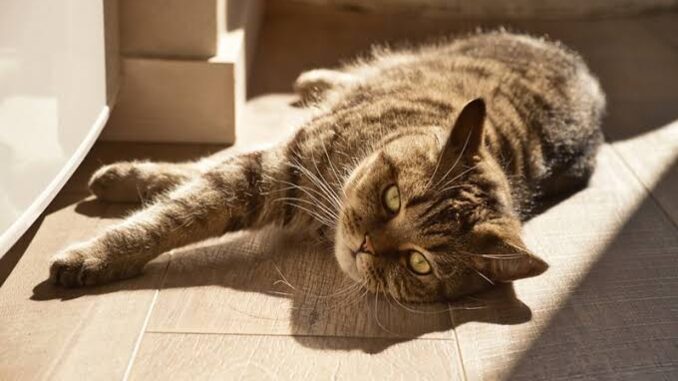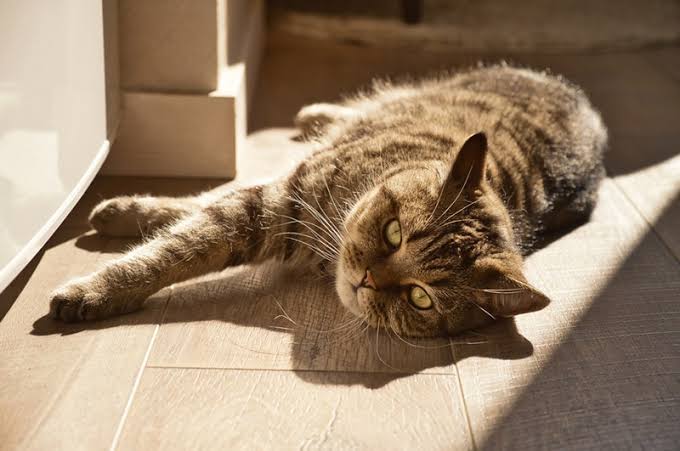
Why Cats Love Sunbathing And Is It Safe? If you live with a cat, you’ve likely seen them sprawled out in a sunny window, stretching luxuriously across a patch of sunlight on the floor. Whether it’s a hot summer day or a cool winter morning, cats naturally seek out the warmest spots and more often than not, those spots are bathed in sunlight.

But why are cats so drawn to sunbathing? Is it just a preference for warmth, or is there more to the story? And importantly is sunbathing safe for your cat?
This in-depth guide explores the science, instincts, and safety considerations behind your feline friend’s sun-worshipping behavior.
Why Do Cats Love Sunbathing?
Let’s start with the basics: sunbathing just feels good. But for cats, it serves several deeper purposes rooted in biology and behavior.
1. Warmth = Comfort = Energy Conservation
Cats have a resting body temperature of about 102°F (38.9°C), which is slightly higher than humans. Maintaining that warmth requires energy—especially when they’re resting or sleeping.
By lounging in a sunbeam, your cat is absorbing external heat, reducing the energy they must use to keep warm. It’s energy-efficient. Think of it as feline solar power.
Fun Fact: Cats conserve energy because, in the wild, they use short bursts of intense energy to hunt. That’s why they rest—often in warm places—for most of the day.
2. Cats Sleep a Lot — and the Sun Makes Naps Better
Cats sleep 12–16 hours a day, with older cats sometimes reaching 20 hours. Much of that time is spent in “light sleep,” where they’re still semi-aware of their environment.
The sun provides physical and psychological comfort, much like how we might snuggle under a blanket. It creates the ideal conditions for deep, restorative cat naps.
3. Instinctual Behavior from Wild Ancestors
Cats evolved in warm climates like Africa and the Middle East. Their ancestors often sought out sunny rocks and desert landscapes to bask and rest.
That sun-seeking behavior is deeply hardwired into their instincts. Even the most pampered housecat still carries those desert-born tendencies.
4. Sunlight and Vitamin D: Myth vs. Fact
Here’s a common misconception: “Cats sunbathe to get vitamin D, just like humans.” That’s actually not true.
Unlike humans, cats do not synthesize vitamin D through their skin. Instead:
- Vitamin D collects on their fur when exposed to UV light.
- When they groom themselves, they ingest small amounts of it.
So while sunbathing contributes slightly to their vitamin D intake, it’s not the primary source. Most vitamin D for cats comes from their diet, not sunlight.
5. Sunspots Provide Territorial Satisfaction
Cats are territorial animals. A sunny spot is not just warm—it’s claimable real estate. When your cat stretches into a sunbeam on the floor or windowsill, they’re often marking that space with their scent.
It becomes a personal comfort zone—a familiar, safe, warm space that satisfies their psychological need for territory.
Is Sunbathing Safe for Cats?
For the most part, yes—in moderation. But there are several important risks to be aware of, especially with indoor cats who lounge in the sun for long periods or outdoor cats who spend hours exposed to UV rays.
1. Sunburn in Light-Colored Cats
Just like humans, cats can suffer from sunburn, especially those with:
- White or light-colored fur
- Thin or patchy coats
- Pink noses and ears
These areas are particularly vulnerable. The ears and nose are most at risk of developing solar dermatitis or even skin cancer (like squamous cell carcinoma) after chronic exposure.
Watch for signs like crusty, red, or flaking ear tips in white cats.
2. Overheating and Heat Stroke
Cats can overheat if sunbathing too long, especially in rooms with little airflow or during hot summer months. While they’re good at self-regulating, elderly cats, kittens, and brachycephalic (flat-faced) breeds are more vulnerable.
Signs of overheating include:
- Panting
- Drooling
- Lethargy
- Vomiting or collapse
If this happens, move your cat to a cool place and contact your vet immediately.
3. The Dangers of Human Sunscreen
Never apply human sunscreen to your cat. Many contain toxic ingredients like:
- Zinc oxide
- PABA
- Fragrances
These can be harmful or fatal if ingested during grooming. If sun protection is needed, ask your vet for a pet-safe sunblock specifically formulated for animals.
4. Sunlight and Indoor Toxins
Indoor cats often sunbathe on window sills or near plants. If you’re using cleaning sprays or pesticides on those surfaces—or have toxic houseplants like lilies—it can pose a danger when licked off during grooming.
Keep sunny spots clean, pet-safe, and plant-free to avoid exposure to hidden toxins.
Tips for Safe Indoor Sunbathing
Sunbathing is generally safe and even beneficial for cats when managed wisely. Here’s how to create safe, cozy sunspots in your home:
1. Provide Ventilation
Ensure the room has good airflow. Crack open a window or run a ceiling fan (safely).
2. Use Sheer Curtains or Window Film
This diffuses UV rays while still allowing light and warmth, reducing the risk of sunburn.
3. Rotate Sunspots
Encourage your cat to nap in multiple places so they don’t lie in one intense sunbeam for hours.
4. Check Skin and Fur Regularly
Especially in light-colored cats. Look for crustiness, redness, or lesions—particularly on the nose, ears, and eyelids.
5. Offer Shade and Cool Retreats
Place a cool mat or shaded bed near sunny areas so your cat can choose to cool down easily.
6. Keep Water Nearby
Cats can become mildly dehydrated during extended sunbathing. A nearby water source encourages better hydration.
READ ALSO: How to Create a Pet Emergency Kit
What About Outdoor Cats?
Outdoor cats love basking on decks, garden walls, or rooftops. While they benefit from fresh air and sunlight, they also face greater risks:
- UV-related cancers (especially in white cats)
- Overheating during peak summer hours
- Parasites and skin irritations from hot surfaces
If your cat has outdoor access, consider these tips:
- Limit sun time between 10 a.m. – 4 p.m.
- Use shaded catios (cat patios) with built-in coverings
- Check ears and noses regularly
- Consider clothing or protective gear for sensitive cats
FAQs
Why does my cat switch spots throughout the day?
Cats follow the sun as it moves across the house. It’s a combination of seeking warmth, comfort, and adjusting body temperature based on changing conditions.
Can cats get skin cancer from sun exposure?
Yes especially white cats or those with light skin/fur. Chronic exposure to UV rays can lead to skin cancer, particularly around the nose, eyelids, and ear tips.
Should I limit my cat’s sunbathing?
Not necessarily. Let them enjoy it—but ensure the area is well-ventilated, they can move to shade, and you check for early signs of overheating or skin irritation.
Is a sunlamp or heated bed a safe alternative?
Yes! Heated cat beds or pet-safe sun lamps can provide warmth in colder months without the UV risks of sunlight—especially for elderly or arthritic cats.
My cat pants when sunbathing is that normal?
No. Panting in cats is not normal (unlike dogs) and could indicate overheating or stress. Move your cat to a cooler area and monitor closely.
Can I apply sunscreen to my cat?
Only if it’s veterinary-approved, cat-safe sunscreen. Never use human sunscreen, as many ingredients are toxic to cats.
Leave a Reply
You must be logged in to post a comment.